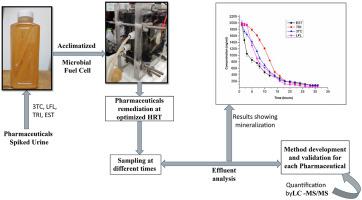当前位置:
X-MOL 学术
›
J. Pharm. Anal.
›
论文详情
Our official English website, www.x-mol.net, welcomes your
feedback! (Note: you will need to create a separate account there.)
Probing the degradation of pharmaceuticals in urine using MFC and studying their removal efficiency by UPLC-MS/MS
Journal of Pharmaceutical Analysis ( IF 6.1 ) Pub Date : 2020-04-30 , DOI: 10.1016/j.jpha.2020.04.006 Priya Sharma 1 , Devendra Kumar 2, 3 , Srikanth Mutnuri 1
Journal of Pharmaceutical Analysis ( IF 6.1 ) Pub Date : 2020-04-30 , DOI: 10.1016/j.jpha.2020.04.006 Priya Sharma 1 , Devendra Kumar 2, 3 , Srikanth Mutnuri 1
Affiliation

|
Nutrient recovery from source-separated human urine has attracted interest as it is rich in nitrogen and phosphorus that can be utilized as fertilizer. However, urine also contains pharmaceuticals, steroid hormones, etc. and their removal is crucial as they have detrimental effects on the environment and human health. The current study focuses on investigating the degradation of pharmaceuticals using a double-chamber microbial fuel cell (MFC). Urine was spiked with four pharmaceuticals (trimethoprim, lamivudine, levofloxacin, and estrone) at a concentration of 2 μg/mL. The MFC was operated for 7 months in batch mode with this spiked urine as feed. The degradation efficiency of the MFC was studied, for which a selective liquid chromatography-tandem mass-spectrometric method was developed for the quantitation of compounds used in the spiking experiments and was validated with a lower limit of quantification of 0.39 ng/mL. The maximum removal rate achieved was 96% ± 2%. The degradation mechanism involved processes like sorption and anoxic biodegradation. The voltage curve obtained showed that the presence of pharmaceuticals had an initial negative impact on power generation along with increased organic content; however, after the reactor acclimatization, increased power output was achieved with maximum organics removal at 30 h of retention time. This work opens a new perspective for the anoxic biodegradation of pharmaceuticals and can be useful in future bioremediation studies.
中文翻译:

使用 MFC 探究尿液中药物的降解并通过 UPLC-MS/MS 研究其去除效率
从源头分离的人类尿液中回收养分引起了人们的兴趣,因为它富含氮和磷,可以用作肥料。然而,尿液中还含有药物、类固醇激素等,去除它们至关重要,因为它们对环境和人类健康有不利影响。目前的研究重点是使用双室微生物燃料电池(MFC)研究药物的降解。尿液中添加了浓度为 2 μg/mL 的四种药物(甲氧苄啶、拉米夫定、左氧氟沙星和雌酮)。 MFC 以分批模式运行 7 个月,并以这种加标尿液作为饲料。研究了 MFC 的降解效率,为此开发了一种选择性液相色谱-串联质谱方法来定量加标实验中使用的化合物,并以 0.39 ng/mL 的定量下限进行了验证。达到的最大去除率为 96% ± 2%。降解机制涉及吸附和缺氧生物降解等过程。获得的电压曲线表明,随着有机物含量的增加,药物的存在对发电产生了最初的负面影响;然而,在反应器适应后,功率输出增加,保留时间为 30 小时,有机物去除量最大。这项工作为药物的缺氧生物降解开辟了新的视角,可用于未来的生物修复研究。
更新日期:2020-04-30
中文翻译:

使用 MFC 探究尿液中药物的降解并通过 UPLC-MS/MS 研究其去除效率
从源头分离的人类尿液中回收养分引起了人们的兴趣,因为它富含氮和磷,可以用作肥料。然而,尿液中还含有药物、类固醇激素等,去除它们至关重要,因为它们对环境和人类健康有不利影响。目前的研究重点是使用双室微生物燃料电池(MFC)研究药物的降解。尿液中添加了浓度为 2 μg/mL 的四种药物(甲氧苄啶、拉米夫定、左氧氟沙星和雌酮)。 MFC 以分批模式运行 7 个月,并以这种加标尿液作为饲料。研究了 MFC 的降解效率,为此开发了一种选择性液相色谱-串联质谱方法来定量加标实验中使用的化合物,并以 0.39 ng/mL 的定量下限进行了验证。达到的最大去除率为 96% ± 2%。降解机制涉及吸附和缺氧生物降解等过程。获得的电压曲线表明,随着有机物含量的增加,药物的存在对发电产生了最初的负面影响;然而,在反应器适应后,功率输出增加,保留时间为 30 小时,有机物去除量最大。这项工作为药物的缺氧生物降解开辟了新的视角,可用于未来的生物修复研究。











































 京公网安备 11010802027423号
京公网安备 11010802027423号